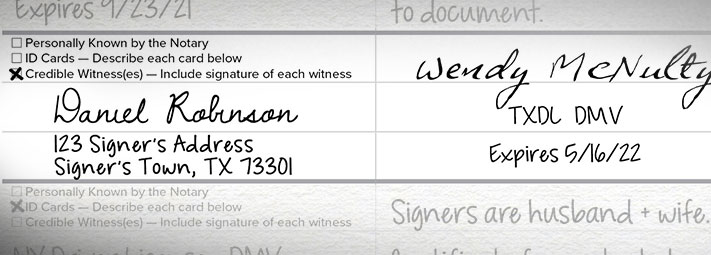Updated 1-8-24. Texas allows Notaries to identify the signer through a credible identifying witness. A credible witness is an individual who personally knows the signer and can vouch for the signer’s identity to the Notary.
If you use a credible witness to identify a signer, what information do you need to write in your journal? Here’s what Texas Notaries need to know about recording credible witness information in a journal entry.
Texas requirements for a credible witness
In Texas, a credible witness must either personally know the Notary or must present to the Notary a valid, unexpired ID issued by the federal or a state government that contains the photo and signature of the witness (1 TAC 87.40[2] and 87.1[1]).
A credible witness must know the signer well enough to be able to swear or affirm the signer’s identity before the Notary.

Texas journal entry requirements for a credible witness
Under state law, Government Code Section 406.014(6) requires Texas Notaries to record the following information in the journal entry when a credible witness identifies a signer:
1. The name of the credible witness.
2. The residence address of the credible witness.
If you need additional room to enter information about multiple witnesses, you can also use the “Additional Information” section of your journal entry.
See the sample credible witness information for a Texas journal entry in the photo above as a guide.
Texas Notary journal restrictions
Texas Notaries are prohibited by law (1 TAC 87.50[a][1]) from recording the serial or identifying numbers on identification documents in their journal entries. If a credible witness presents you with ID, remember that you must not record the ID number in your journal.
David Thun is the Assistant Managing Editor with the National Notary Association.
Related Articles:
A Notary’s guide to completing journal entries
What every Notary needs to know about journals